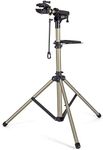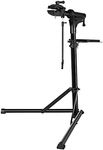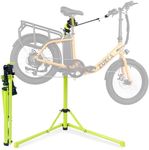Buying Guide for the Best Bike Repair Stands
Choosing the right bike repair stand can make maintaining your bicycle much easier and more comfortable. A good repair stand holds your bike securely at a convenient height, freeing up your hands and allowing you to work on your bike safely and efficiently. When picking a repair stand, it's important to consider how you'll use it, the types of bikes you own, and where you'll be working—whether that's at home, in a garage, or on the go.Clamp TypeThe clamp is the part of the stand that holds your bike in place. There are different clamp designs, such as quick-release, screw-tightened, or even clamp-free options that support the bike by the bottom bracket and fork. A good clamp should be easy to use, gentle on your bike’s frame, and secure enough to hold the bike steady. If you have bikes with delicate frames or unusual tube shapes, look for a clamp with adjustable jaws and soft padding. For most home mechanics, a quick-release clamp is convenient and versatile, while more specialized stands may suit those working on high-end or unique bikes.
Weight CapacityWeight capacity tells you how much weight the stand can safely support. This is important because bikes can vary widely in weight, especially if you have electric bikes or heavy mountain bikes. Stands with lower weight limits are fine for lightweight road bikes, but if you plan to work on heavier bikes, make sure the stand can handle the load. Always check the maximum weight rating and choose a stand that comfortably exceeds the weight of your heaviest bike to ensure safety and stability.
Height AdjustabilityHeight adjustability refers to how much you can raise or lower the stand to suit your working position. Being able to adjust the height is important for comfort and ergonomics, as it allows you to work on different parts of the bike without straining your back. Some stands offer a wide range of adjustment, while others are more limited. If you’re tall, short, or plan to share the stand with others, look for a model with a broad height range so everyone can work comfortably.
Portability and StoragePortability and storage describe how easy it is to move and store the stand when not in use. Some stands are lightweight and fold up compactly, making them ideal for people with limited space or those who want to take the stand to races or group rides. Others are heavier and more robust, designed to stay in one place. If you need to store the stand in a small area or transport it frequently, look for a model that folds easily and isn’t too heavy to carry.
StabilityStability is about how steady the stand is when you’re working on your bike. A stable stand prevents tipping and wobbling, which is especially important when applying force to stuck bolts or pedals. Stands with wide, sturdy bases or tripod designs tend to be more stable, especially on uneven surfaces. If you plan to do heavy repairs or work on large bikes, prioritize stability to keep your bike and yourself safe.
Rotation and Angle AdjustmentRotation and angle adjustment allow you to spin or tilt your bike while it’s in the stand, making it easier to access different parts. Some stands let you rotate the bike 360 degrees or lock it at various angles. This feature is useful for tasks like adjusting derailleurs or working on the underside of the bike. If you want maximum flexibility and ease of use, look for a stand with smooth, secure rotation and angle adjustment.
















